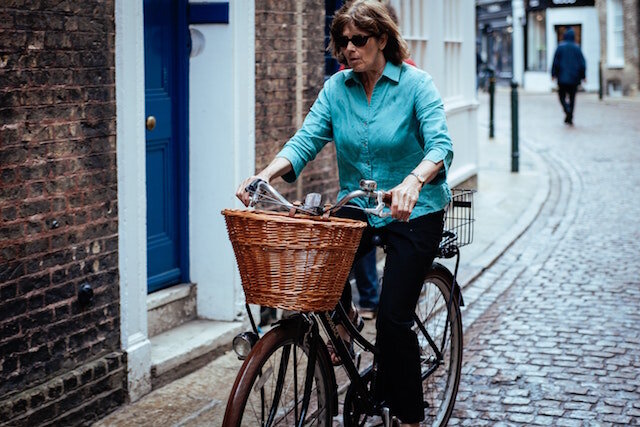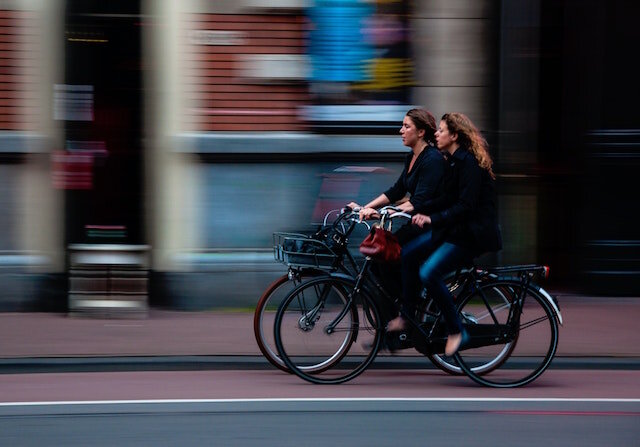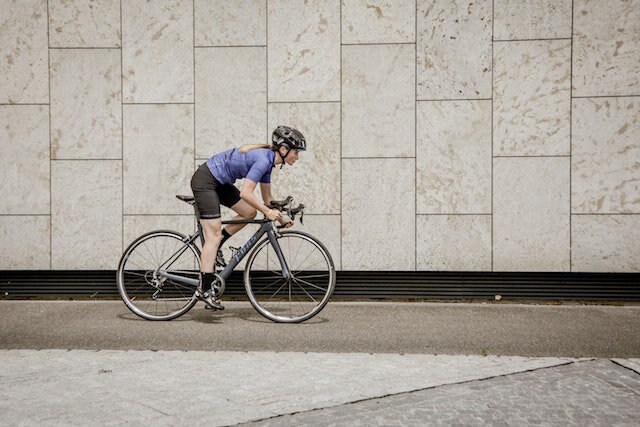“A comfortable, ideally seamless, sports bra is essential for cycling, and mountain bikers will want extra support and stability. ”
In 1977 runners Hinda Miller and Lisa Lindahl sewed together two athletic supports or “jockstraps” and created the prototype of the modern-day sports bra. This “Jockbra” was later rebranded under the name Jogbra, for obvious reasons.
If you have small breasts that don’t move much while cycling, you’re unlikely to suffer from exercise-induced breast discomfort.
However, if your breasts move a lot when you’re cycling or mountain biking, or if you experience breast pain/discomfort, even if your breasts are small, a supportive bra is an absolute must and will make your ride even more enjoyable and relaxing.
Do I need a sports bra for cycling?
- Yes. You should wear a sports bra during any activity that causes breast movement which encompasses all forms of cycling and mountain biking.
- Vigorous forms of cycling and mountain biking cause breast bounce, which leads to breast discomfort and stretching and is easily minimized by wearing a correctly fitting sports bra.
FUN FACT: The first commercially available jogbra (1977) sold for $8.00, which is nearly equal to $35.00 today (2020).
How do I know if I need a sports bra?
If you experience breast pain or discomfort from bouncing boobs, then you need to wear a sports bra. Breast bouncing during cycling and mountain biking should be minimized to increase comfort, performance, and pedal efficiency.
Cycling: Sports bra & efficiency
Sports bras work by allowing the breasts and trunk of the body to move as one unit, which is mimicking the motion of males.
Wearing a proper-fitting supportive bra reduces the activity of the “pec” muscles by 55%, which causes you to get fatigued quicker, especially while mountain biking.
“A woman’s choice of breast support can also influence her breathing rate, lung capacity and thermoregulation during exercise”
The bigger the breasts, the heavier, for example, a size 34B (75B in EU) weighs about 7 ounces (200grams) and a size 38D (85D in EU) weighs about 1.5 pounds (700gram). The heavier the breasts, the more movement, which will cause you to use more energy without the right amount of chest support.
When breasts bounce during activities, they don’t bounce in unison nor do they bounce in coordination with your torso. In addition to this causing discomfort, it also is very inefficient and will require you to expend more energy to maintain the same power output while pedaling.
So a sports bra can make me faster?
While no direct studies have been conducted that look specifically at cycling performance and breast support, several studies have researched running performance while wearing sports bras. The researchers found:
Significant reductions in “pec” muscles activity with reductions of over 60% during endurance events
Shoulder and deltoid activation was also significantly higher without adequate bra support (similar to “pec” activation)
Decreased efficiency through modifications in running mechanics and stride length and frequency
While cycling and running are different, the increased activation of upper body muscles during cycling can lead to increased energy demands and fatigue. If you are out riding all day, wearing a sports bra can make you faster by not wasting precious calories and energy.
intensity, age, size, activity & extra support
“If your breasts move a lot during exercise or if you suffer from exercise-induced breast discomfort, even
if they are small, a supportive bra is an absolute must.”
Any activity that causes your bosoms to bounce, especially if they move excessively and frequently, then you should be wearing a sports bra for extra support.
All breasts sit on top of the pectoralis muscles (“pecs”) and are attached to your body only by the Cooper’s ligament and your skin. The heavier the breasts, the more movement.
The amount of breast support needed varies with age, bra size, type of exercise, and intensity:
“Cooper’s ligaments and the skin are the only anatomical structures that provide any breast support.”
Age - As you age, your skin thins and its elasticity decreases. Breasts are only attached to the chest by the Cooper’s Ligament and skin, so more movement occurs as you age
Size - Large breasts weigh 1.5 to 2+ pounds (700g to 1kg). Larger breasted women will need more support as larger breasts move more
Activity - Any activities that cause vertical movements of the body cause more breast movement and require greater breast support
Vertical movement exercises = running, horseback riding, basketball, volleyball, and mountain biking
Intensity - The more vigorous the intensity, the more support you will need. Going from a walk to a jog or a leisurely bike ride to intense cycling will require extra support.
Breast Movement, Dynamic Activities, & Bra Type
“The ratio of fat to connective tissue content determines the firmness of the breast”
Leisurely cycling & sports bra
Excessive breast movement during activities like jogging and jumping can cause breast discomfort.
However, leisurely cycling on a beach cruiser or commuter bike causes minimal breast movement or discomfort and generally doesn’t require the wearing of a sports bra.
Leisurely cycling
Low impact
Minimal forward lean
Upright sitting posture: No forward lean as cruiser and commuter bikes are designed for maximum rider comfort and upright sitting
road cycling, exercise-induced breast pain, & sports bra
“As our study shows, everyday bras trigger exercise-induced breast discomfort and cause greater vertical bra movement during chest expansion”
Road cycling, especially when getting “aero” or riding in the drops places you in a less supportive position. Also, going from seated pedaling to standing, high-speed cornering, and fast braking, all-cause excessive breast movement.
If you are a serious road cyclist or participate in vigorous indoor cycling, it’s recommended to wear a sports bra. 3D motion studies show that breasts move 30% more from a standing position to walking, with over triple the movement going from a walk to a run, with cycling falling in the middle of this range.
You should keep in mind, that for bike touring or long-distance road cycling, having extra support makes you more efficient, even if you don’t have any comfort issues.
Mountain biking & wearing a sports bra
Mountain biking, especially riding technical singletrack and downhilling steep MTB paths, causes large amounts of breast movement and a sports bra should be worn.
Cycling during hormonal changes
Throughout normal hormonal changes during your menstrual cycle, your breasts will be at their most sensitive, which could require extra support and even a different size bra.
Breast pain commonly increases from ovulation and will ease during menstruation. Being in rhythm with your cycles and utilizing the correct bra during the right time is important for your breast comfort and enjoyment of your pedal time. Keep in mind that breasts during this time can be larger and/or heavier, due to increased fluid retention.
Sports bra fit
“A bra can only function properly if it fits you ”
It does not matter how supportive your bra is if it's not fitting right. Studies estimate that 85% of women are currently wearing the wrong size bra.
If you're currently wearing a sports bra and still experience discomfort, you might be part of the 85% club.
Also, keep in mind that bras have a used by date. Worn bras become stretched and have little elastic properties, which means not much support.
about the authors
Valentina is a guide for Pedal Chile and is our resident badass. Valentina was born and raised in La Patagonia, which probably explains her affinity for adventuring. When Valentina isn’t crushing some poor dude’s soul, you can find her shredding down Rucapillán. Favorite season: Austral Summer
Jesse is Director of Pedal Chile and lives in Valdivia, Chile. Jesse has a Master of Science in Health & Human Performance and a Bachelor of Science in Kinesiology. Hobbies: MTBing, snowboarding, reading, taster of craft beers, researcher, & compression sock wearer.
“This thesis is dedicated to all the female athletes who have felt some how limited by their breasts”
Sources:
Barton, R. (2011). The cycling bible : the complete guide for all cyclists from novice to expert. Guilford, Conn.: Falcon Guides.
Breast Research Australia (2008). Sports Bra Fit. [online]
Brisbine, B., Steele, J., Phillips, E. and McGhee, D. (2019). Elite female athletes experience breast injuries that affect their performance. Journal of Science and Medicine in Sport, 22, pp.S67–S68.
Gefen, A. and Dilmoney, B. (2007). Mechanics of the normal woman’s breast. Technology and Health Care, [online] 15(4), pp.259–271.
Gibson, Taylor M et al. “Reductions in Kinematics from Brassieres with Varying Breast Support.” International journal of exercise science vol. 12,1 402-411. 1 Mar. 2019
Haake, S. and Scurr, J. (2010). A dynamic model of the breast during exercise. Sports Engineering, 12(4), pp.189–197.
Henry, P. (2020). Support your breast friends: A search for the perfect sports bra. [online] Health & HP.
Liang, R., Yip, J., Yu, W., Chen, L. and Lau, N.M.L. (2019). Numerical simulation of nonlinear material behaviour: Application to sports bra design. Materials & Design, 183, p.108177.
Lu, M., Qiu, J., Wang, G. and Dai, X. (2016). Mechanical analysis of breast–bra interaction for sports bra design. Materials Today Communications, 6, pp.28–36.
McGhee, Deirdre E.; Steele, Julie R. Biomechanics of Breast Support for Active Women, Exercise and Sport Sciences Reviews: July 2020 - Volume 48 - Issue 3 - p 99-109 doi:
Mills, C., Risius, D. and Scurr, J. (2014). Breast motion asymmetry during running. Journal of Sports Sciences, 33(7), pp.746–753.
Norris M, Mills C, Sanchez A, et al. Do static and dynamic activities induce potentially damaging breast skin strain? BMJ Open Sport & Exercise Medicine2020;6:e000770. doi:10.1136/bmjsem-2020-000770
Risius, D., Milligan, A., Mills, C. and Scurr, J. (2014). Multiplanar breast kinematics during different exercise modalities. European Journal of Sport Science, 15(2), pp.111–117.
Schultz, J. (2014). Qualifying times : points of change in US women’s sport. Urbana: Univ. Of Illinois Press.
Wang, C.-S., Wang, L.-H., Kuo, L.-C. and Su, F.-C. (2017). Comparison of breast motion at different levels of support during physical activity. Journal of Human Sport and Exercise, 12(4).
Zhou, J., Yu, W. and Ng, S.-P. (2012). Studies of three-dimensional trajectories of breast movement for better bra design. Textile Research Journal, 82(3), pp.242–254.






















